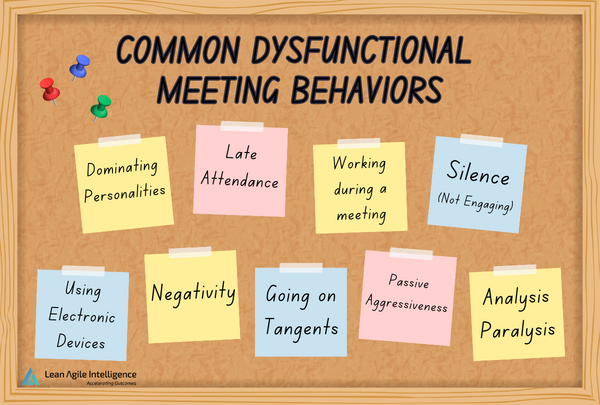Agile Retrospective Doesn't Have To Be Painful (Part 2)
By Team Lean Agile Intelligence

Agile Retrospective and Planning For Dysfunction
The number one complaint we hear when consulting is “There are too many meetings!.” There are many potential underlying causes for this sentiment.
In this blog post, we will be addressing a root cause that is not often discussed but is crucial to the success of your teams and organization. This is part 2 of our series on how to improve retrospectives. You can read our first post on using an empirical approach to make your retro productive here.
The first and most obvious root cause is there are too many meetings OUTSIDE of your reoccurring events. The potential impact of this is dissatisfaction with the regularly scheduled events because they may seem like additional time outside of “working.” Ryan Ripley has a great video about this and how to remediate this issue. Meetings can be frustrating and seen as a waste of time when they are ineffective. Dysfunctional behaviors happening before, during, and after a meeting could be a root cause.
HOW A FACILITATOR CAN HELP
It’s the responsibility of the meeting facilitator to plan for meeting dysfunction and use facilitation and coaching skills to remediate these dysfunctions. In this post, we will cover some common dysfunctional behaviors and steps you can take to have great and effective meetings that people WANT to attend.
Since the first value of the Agile manifesto is “Individuals and Interactions or Processes and Tools.” It’s critical we are able to collaborate effectively in order to achieve the desired results.

Some Common Dysfunctional Meeting Behaviors:
- Dominating personalities:
-
When one individual is controlling or dominating the conversation others may not feel comfortable contributing. Often this is someone who has a position of authority in a meeting or someone who enjoys controlling the conversation or ideas.
-
- Passive Aggressiveness
-
Passive-aggressive behavior appears in different ways such as someone not speaking with someone or avoiding them in a meeting, or avoiding showing up to the meeting together. Another obvious form is someone who claims “I’m fine, let's move on” when things are clearly not fine, creating an awkward environment for the meeting.
-
- Negativity
-
This is a pretty straightforward one. Someone who always brings the group down by focusing on the negative or avoiding action by telling the group nothing can be done.
-
- Silence (Not speaking or engaging)
-
This is a very common dysfunction remotely but still exists in the person. If we are to function as a team or collaborative group in a meeting, we need to hear ideas and opinions from everyone in the group.
-
- Late Attendance
-
When someone is habitually late it can cause not only meeting disruption but wasted time by having to repeat things which can lead to resentment in the group.
-
- Working during a meeting
-
Many of us have done it, but when we multi-task during a meeting it’s very distracting for others, it’s impossible to pay full attention, and shows a level of non-commitment to the current objectives the group is attempting to achieve.
-
- Constantly using electronic devices
-
Have you ever been in a meeting and everyone has their laptops open typing, checking email, their phone, etc? How productive are those meetings usually? If we can’t commit 30 minutes (for example) to focus together on achieving the outcome we set to achieve for the meeting, then we shouldn’t have the meeting in the first place.
-
- Going on Tangents
-
This manifests itself usually by someone going down a verbal rathole about a topic unrelated to the meeting agenda.
-
- Analysis Paralysis
-
This is common when a meeting is made up of many analytical people. The end result is a lot of good discussions but no or very few decisions being made.
-

I’m sure you can think of dysfunctional behaviors you have witnessed outside of this list. This is just meant to be a starting point!
Now that we have identified some common dysfunctions, we should plan for them and facilitate around them.
Note: every one of us can demonstrate dysfunctional meeting behaviors. People aren’t dysfunctional, the behavior is, and behavior can change through facilitation techniques, coaching, teaching, and 1:1’s.
STEPS TO PLAN FOR DYSFUNCTION
Let's take a look at the four steps that you can take to plan for handling dysfunction before conducting an agile retrospective.
STEP 1
Reflect on the past or plan for possibilities
If you are facilitating upcoming meetings and events with people you have previously been in meetings with, write down the patterns of behavior you have observed. If it’s a brand-new set of people, then write down the dysfunctions above to plan for possibilities.
STEP 2
Define the pre-work
After you have the list of dysfunctions or potential dysfunctions, define what work should be done prior to the meeting to address them.
For example: If people are arriving late often, creating working agreements before the meeting you are planning to facilitate would be a pre-emptive option.
Another example of pre-work would be addressing a dominating personality. Having a 1:1 with that individual prior to the meeting and walking them through what you are trying to accomplish as the facilitator and how they could potentially help achieve it would be another pre-emptive option.
STEP 3
Design the meeting
Design your facilitation of the meeting in such a way that addresses the dysfunctions.
For example: For silent dysfunction, utilize silent writing and silent brainstorming techniques or provide the ability for people to add input prior to the meeting to collect data. Another option is to use a round-robin technique, such as “pass the ball”
Another example would be electronic devices and multitasking. If you are collocated, you can design the seating of the room to naturally discourage the usage of laptops. Also, you can establish a working agreement at the beginning of the meeting regarding electronics that the group will adhere to and ask permission to remind them of it when broken.
STEP 4
Retrospect
After each meeting that you facilitate, perform a personal retrospective on how it went and what dysfunctional behaviors you observed.

In Conclusion:
In conclusion, meetings can be frustrating and seen as a waste of time when they are ineffective. Dysfunctional behaviors happening before, during, and after a meeting could be a root cause. Therefore, it’s the responsibility of the meeting facilitator to plan for meeting dysfunction and use facilitation and coaching skills to remediate these dysfunctions. The post has covered some common dysfunctional behaviors and steps you can take to have great and effective meetings that people want to attend. By reflecting on the past, defining pre-work, designing the meeting, and following up on action items, facilitators can plan for handling dysfunction before conducting a meeting. It’s important to keep in mind that every one of us can demonstrate dysfunctional meeting behaviors, but people aren’t dysfunctional, the behavior is, and behavior can change through facilitation techniques, coaching, teaching, and 1:1’s. Effective meetings are crucial for successful teamwork and collaboration. Interested in learning more about the strategies to improve your team's retrospectives? Check out our blog post on Team Retrospective, from boring to brilliant with inspect and adapt.
FOR FURTHER READING ON FACILITATION:
The Facilitators Guide to Participatory Decisions Making – Sam Kaner
Gamestorming by Dave Gray
System’s Thinking Playbook by Linda Booth Sweeney and Dennis Meadows
The Coach’s Guide to Facilitation – Karen Greaves and Sam Laing
Facilitating with Ease by Ingrid Bens.
Collaboration Explained by Jean Tabaka.
Agile Retrospectives by Esther Derby and Diana Larsen.